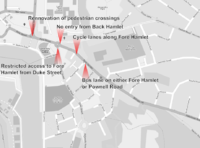Ipswich dock

Duke Street developments
|
|
| Location | Ipswich |
|---|---|
| Proposer | Suffolk County Council |
| Website | Link |
| Status | approved |
| Type | road |
| Cost estimate | £3.5 million |
| Start date | 2010 |
| Geometry | KML |
| Location | Ipswich |
|---|---|
| Proposer | Ipswich Borough Council |
| Status | proposed |
| Type | road |
| Cost estimate | £28 million |
| Completion date | 2018 |
The Ipswich Dock, (also the waterfront, Ipswich wet dock and the wet dock,) is the area of land around the dock in the town of Ipswich at a bend of the River Orwell which has been used for trade since at least the 8th century. A wet dock was constructed in 1842 which was 'the biggest enclosed dock in the kingdom' at the time. A major regeneration of the area has taken place since 1999.
A dock was in operation in Ipswich on a bend in the River Orwell in the 8th century, and was probably established during the 7th century under the protection of the ruling house of the Kingdom of East Anglia, which reached its summit under King Raedwald. The importance of this dock, and the surrounding town which served it, has been recognized through excavation over the past fifty years. The early town of Ipswich (then called Gipeswic), centred upon the quay, extended over more than 52 hectares, the area later enclosed by the Viking age ramparts (which curtailed the Anglo-Saxon township), making it one of the largest new early post-Roman townships and emporia in northern Europe. Imported pottery of Rhenish Merovingian types, imported lava quern-stones and barrel-timbers dendro-dated to 8th century Germany, and finds of continental coinage such as 'porcupine sceattas' indicate trade through the Rhine port towns including Domburg, Dorestad and Andernach, as part of the cultural engagement of Anglo-Saxon England with the Frisian, Frankish, Alamannic, Saxon, Thuringian and Burgundian worlds. The important 'Ipswich Ware' pottery industry, established in the town's north-east quarter probably in the late 7th century, reflected shapes and kiln technologies based on Frisian prototypes, either in imitation of imports arriving at the quay or set up by migrant Frisian workers. The Gipeswic dock was therefore the trade capital of the East Anglian Kingdom, situated not far from its royal centre at Rendlesham and Sutton Hoo. During the 7th and 8th centuries the two greatest English ports were York (Eoforwic) and London, and two principal new ports were Gipeswic in the east and Hamwic (Southampton) in the south. Like Hamwih, Gipeswic dock was therefore a point of departure and arrival for continental travel.
...
Wikipedia
